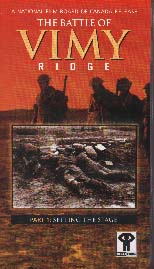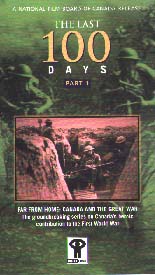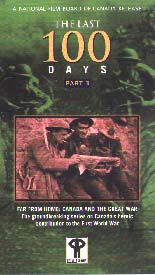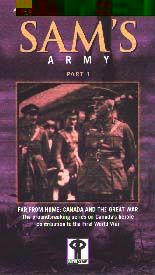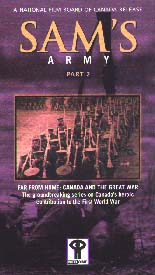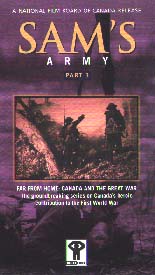|
________________
CM . . . .
Volume VII Number 14 . . . . March 16, 2001
Montreal, PQ: Norflicks Productions Ltd. in association with CHUM Television, the CBC and the
National Film Board of Canada, 1999.
Grades 11 and up / Ages 16 and up.
Far From Home: Canada and the Great War, the NFB series of ten
videos which totals just over five hours of viewing time, examines
Canada's role in World War I. The so-called Great War was a watershed for
Canada: in terms of its self-perception, and its perception in the eyes of
the international community. Historians attribute the experience of the
war as giving Canadians collectively a new sense of identity; and an
acceleration toward full autonomy as a freestanding nation. Canada's
performance in the war was renowned both in terms of its sheer size and
the quality of its fighting forces. Despite the carnage and grief that
characterized this "war of everybody's making but nobody's choosing",
Canada's contribution was one warranting national pride. A commemoration
of that contribution is quite appropriate, as is the effort to provide
some comprehensive historical understanding of an event so central to the
nation's history.
An examination of one nation's war has some inevitable limitations that are obvious in the videos: we
are given one lens to view a complex global conflict. Consequently, we are seeing only aspects of the
war, rather than a comprehensive overview. Other partners, such as Britain, France and the United
States, enter the picture only as their actions touch on the Canadian story. The viewer best able to
appreciate the series, then, is one who has a comprehensive understanding of the broad conflict and is
able to assess the story against that backdrop. The neophyte will not come away with a coherent
understanding of the war itself but will have some sense of what the experience was like for those who
lived through it at home and in battle and what the larger events meant for the development of the
Canadian consciousness and nation-state.
The videos consist of well-chosen archival footage, interspersed with realistic reenactments of seminal
events. In addition, very effective use is made of the words of ordinary participants, as well as of the
military and political leaders who shaped and misshaped events. Readings from letters, diaries and
dispatches including several from those at home add a striking human dimension that makes the
conflict one facing real people not distant and now irrelevant museum pieces. The series will be of
benefit to any viewer and will be of value in any history class or any discussion addressing the evolution
of Canadian society in the twentieth century.
Sam's Army. excerpt: "Sam Hughes was not your standard-issue military leader. Canada's World War I Minister of Militia and Defense concentrated power in his own hands, insisted that the Canadian military use the ill-conceived Ross rifle and liberally promoted his cronies. But there was no denying Hughes was a visionary. He assembled the world's largest-ever volunteer army and bucked superiors to keep his ferocious fighting force together in one Canadian Corps." (from video jacket)The course of the war was very much affected by powerful personalities, and Canada's story was no different. The first three tapes trace the mobilization of Canada's forces and their initial engagement on the Western Front. The strange role of General Sam Hughes, one of the most colorful and arrogant figures in Canadian history, is drawn in as balanced a way as is perhaps possible. This was the man who made the cohesive Canadian Corps possible in the face of pressures within the British establishment to absorb the Dominion contingent piecemeal within the imperial forces. This was the man whose efforts raised the largest volunteer army in history and the man who managed to put at its head arguably the best general of the war, Sir Arthur Currie. When events and political foes finally occasioned his demise and departure in 1916, he left behind a mixed political legacy; but militarily he left the most respected and feared fighting force in the allied command and a sense of national self-assertion that would not subsequently be shaken. In addition to events on the Western Front, the videos do an effective job of portraying parallel events on the Home Front: industrial mobilization with its concomitant profiteering; the fostering and festering of anti-French and anti-German sentiments', and the trauma of loss. Recommended. The Battle of Vimy Ridge. excerpt: "It was now the Canadians' turn to brave a maelstrom of razor-edged barbed wire, knee-deep mud, and withering machine-gun fire. Four days and 10,000 casualties later, the Canadians stun the world by seizing the ridge in one of the war's most successful and brilliantly planned offensives." (from video jacket)With the Canadians now established as fighters of renown, the Canadian Corps under Currie found itself used increasingly as the shock troops of the allied forces, with the distinct irony of having the most professional army in the world so terrorized by the most "civilian." This next set of videos traces the Corp's adventures through the murderous Battle of the Somme, eventuating in the Canadian's signal achievement seizing the seemingly impregnable Vimy Ridge. The logistics of this battle which not only won renown for Canada, but also accomplished a fundamentally important strategic breakthrough of the German line are drawn in detail. Emphasized in the course of the story are some of the practices that gave Currie his reputation as a great general his meticulous preparation and rehearsal of every event; his concern for his men preferring to sacrifice equipment rather than soldiers; and his development of tactics ultimately imitated by the rest of the allied forces: the flexible platoon system, the "creeping barrage." We are made to realize as well that the war effort was represented by more than those going "over the top." Sympathetic glimpses are provided as well of the different elements of the combined Canadian effort: the flyers, the observers, the medical staff, the engineers and tunnel diggers; the work battalions. Among the most dramatic moments recounted is one of a battle saved by the heroism of one of those "non-combat units." Recommended. The Last Hundred Days. excerpt: "Much of the credit for Canadian successes lay with General Arthur Currie, leader of the Canadian Corps and the only bona fide military genius Canada has ever produced. Never appreciated at home, he was honoured as a hero in Europe." (from video jacket)In this section, which brings the war to a close, increasingly more is being asked of the Canadian Corps which, instead of having the long-overdue respite to which it was entitled, was thrown almost immediately into the savagery of Passchendaele. Again, the Corp was seen as virtually saving the day or at least saving the command of the supreme allied general Haig. In contrast with Canadian achievement, an almost disdainful portrait is offered of the American contribution and performance. The other allies receive due respect for their efforts, but a less than celebratory assessment is made of their leadership particularly in their dealings with Currie. Through these videos, something of the horror of that experience and of life in the trenches is able to be conveyed (though not with the same impact as the great war memoirs a testimony, perhaps, to the power of the written word). We do, though, have a telling discussion of ailments ranging from trench-foot to shell shock, along with the rather primitive medical devices and moral dilemmas faced by the medical staff in a time when as many perished from wounds, gas and gangrene as from bullets themselves. The Canadian war experience was a unique one for the Canadian troops, who were better led and more humanely treated than their allied counterparts and who functioned more effectively in a force unencumbered by class divisions. Their horror is well documented, but also their idealism and comradeship and their surprise, bitterness and disillusionment in the poor and unsatisfactory truce that ended the fighting. The viewer is left with an admiration of their commitment and sacrifice, and an appreciation of their achievements in the war and for their country but is left as well with a sense that, militarily and politically, their valour may have been in large part wasted by the politicians, then and later. Recommended. Alexander Gregor is Associate Dean (Graduate Programs) in the Faculty of Education, the University of Manitoba.
To comment on this title or this review, send mail to cm@umanitoba.ca.
Copyright © the Manitoba Library Association.
Reproduction for personal use is permitted only if this copyright notice
is maintained. Any other reproduction is prohibited without
permission.
Published by
TABLE OF CONTENTS FOR THIS ISSUE - March 16, 2001.
AUTHORS |
TITLES |
MEDIA REVIEWS |
PROFILES |
BACK ISSUES |
SEARCH |
ORDER |
CMARCHIVE |
HOME
| |||||||||||
